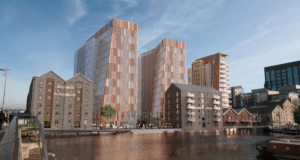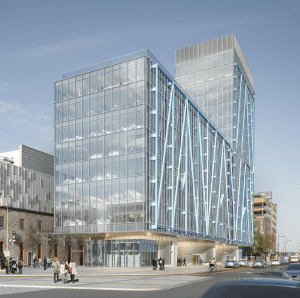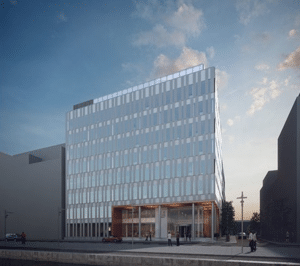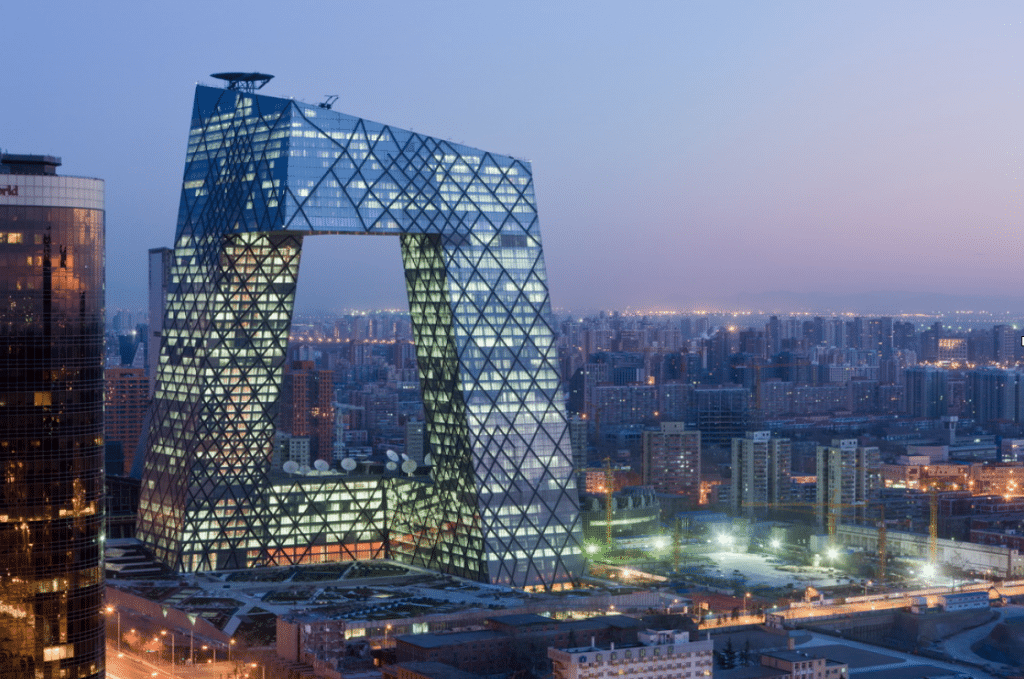TDs returned to the Dáil this week after their summer recess, with their failures in the areas of housing and homelessness still staring them in the face.
Having left the provision of housing to the private sector, Government is now under pressure to react fast. The National Spatial Strategy (2002) has dramatically failed to distribute the population to other cities and hubs outside the capital – sensible policy that might have addressed the demand for accommodation, health services and infrastructure.
It is projected there will be 400,000 more people living in Dublin by 2030 and 600,000 more by 2050.
Developers are taking the opportunity to conflate the two issues of a housing crisis and lack of commercial office space to push for increased building heights in the Dublin City Development Plan to maximise profit.
They happily perpetuate the myth that planning is holding up the supply of housing, most particularly through the restriction on building heights.
So a fragile Dublin City (the functional area of Dublin City Council) is emerging from a devastating recession vulnerable to destructive development fuelled by foreign commercial investment. The intangible international appeal that Dublin holds as a historic centre which attracts many investors in the first place is precisely what is threatened by ill-placed, greedy insertions dominating the terrace, streetscape and skyline.
The concept of height clusters close to major public transport nodes was identified in a study commissioned by Dublin City Council to examine the issue of building height in the context of Dublin: ‘Managing Intensification and Change: A Strategy for Dublin Building Height’ (DEGW, 2000). That document introduced for the first time the crude notion that height in Dublin was not to be assessed relative to adjoining buildings and streets.
-According to Section 4.5.4.1 of the Dublin City Development Plan 2016-2022, ‘Approach to Taller Buildings’:
Dublin City Council acknowledges the intrinsic quality of Dublin as a low-rise city and considers that it should remain predominantly so. The vast majority of the city area is identified as not being suitable for mid-rise or taller buildings. Accordingly, the spatial approach to taller buildings in the city is in essence to protect the vast majority of the city as a low-rise city, including established residential areas and conservation areas within the historic cores.
Meanwhile with former Housing Minister, Simon Coveney’s ‘Rebuilding Ireland – An Action Plan for Housing and Homelessness’ having failed, in the full glare of public and political scrutiny, the Department of Housing, Planning and Local Government’s (DHPLG) solicited public consultations in August with a view to a reworking of plan that will be published later in September.
There are 13 areas in Dublin City that have been designated as either a high-rise or mid-rise area. Aside from these everywhere else is designated as a low-rise area. Most of the mid- to high-rise areas are located in the business districts, the South inner city and certain suburban residential areas.
The City Development Plan envisages clusters of tall buildings of more than 50 metres or the equivalent of 16 residential storeys at four strategic nodes around the city: the Docklands, George’s Quay, and transport hubs around Heuston Station and Connolly Station. To put this in perspective a typical Georgian terrace in Dublin city is 14 metres tall.
As stated in the current Dublin City Development Plan (4.5.4.1):
In all cases, proposals for taller buildings must respect their context and address the assessment criteria set out in the Development Standards Section, to ensure that taller buildings achieves high standards in relation to design, sustainability, amenity, impacts on the receiving environment, and the protection or framing of important views.
The historic city centre is hugely important as part of our urban heritage and identity and it is vital that this unfasionably modest skyline is protected.
Certainly high-rise buildings evince ingenious feats of engineering. In architectural and urbanist terms, they can have a big role in creating identity, structure and a sense of place in appropriately designated areas, but typically outside the fragile characteristically low-rise historic centres of older cities. Clustering tall structures at strategic locations – well-served by public transport – around the city, outside these area makes sense in building a sustainable city for everyone.
So what is happening, on the ground – and in the air?
FORMER BOLAND’S MILL
In Grand Canal Dock, Dublin City Council has approved a fast-track development comprising office accommodation, 42 two- and three-bedroom apartments, a cultural and exhibition space along with retail and restaurant space.

The €150 million scheme is currently under construction to the designs of BKD Architects.
EXO BUILDING
At Point Square (formerly Point Village) the Nama-financed 17-storeys-over-basement Exo building was granted planning permission in March 2016, less than six months after the submission was submitted to Dublin City Council. The building was designed by Shay Cleary Architects, which also designed Alto Vetro, a slim but soaring residential tower in Dublin’s Grand Canal Docks completed in 2009.

The speed at which planning approval was achieved was seen by many as evidence that the designation of the area as a Strategic Development Zone (SDZ) has worked. An SDZ enables the fast track delivery of new residential and non-residential development in locations. It will stand 73 metres tall and accommodate up to 2,000 workers across 15794 sq.m floor space. When completed, Exo will be Dublin’s tallest commercial office building.
PROJECT WAVE
At North Wall a 90,000 sq. m mixed office and residential development including more than 250 apartments is currently under construction. Designed by RKD Architects its dark cladding helps to tone down the sheen of the new Central Bank building next door.
5 HANOVER QUAY / 76 SIR JOHN ROGERSON’S QUAY
Around 27,100 sq. m of office space and 158 residential units also by RKD Architects are nearing completion, developed by a joint-venture consortium between Oaktree, the Bennett Group and NAMA. It comprises a 9,290 sq. m office building and residential accommodation of 72 luxury apartments.

6-8 HANOVER QUAY
The same consortium is developing a further 4,645 sq. m of office space, the flagship European headquarters of AirBnB.
CITY QUAY
In March it was announced that Irish Life would pre-fund the €125m development of 13-18 City Quay. On completion full ownership of the development will be transferred to Irish Life. The 10,962 sq.m scheme was designed by architects Henry J Lyons which also designed the Central Bank building on the opposite side of the Liffey.
SIR JOHN ROGERSON’S QUAY/BRITAIN QUAY
Ironically, some developers are not building to the maximum height permitted, for instance the North Lotts and Grand Canal Dock SDZ Planning Scheme permits U2 and Harry Crosbie to build 22-storey towers, on either side of the Liffey Quays. But the U2 Tower is out of the ground and will only be 18 storeys.
Success and some failure
Most of these developments have cleverly integrated within an established height in their areas. Even the new Boland’s Mill buildings profit from a prevailing high–industrial ethos, and does not really jar with nearby residential streets which have always existed in the shadow of the mills.
One area where excessive height has been designated is the Tara St/George’s Quay are where slavish pursuit of height adjacent to the Dart Station has led to indicative heights of 22 storeys, elevations that would negatively overshadow Trinity Cllege and Merrion Square.
John Ronan’s plans for Dublin’s tallest building, a 22-storey €130m, 88-metre tower with offices and a 110-bedroom hotel beside Tara Street station, described in Village as “the most significant – and worst – scheme ever proposed in the history of Dublin City”, were rejected in the Spring by Dublin City Council.
The building could have been seen incongruously from Grafton St – and Henrietta St. Dublin City Council said the proposal would have a “significant and detrimental visual impact” as far away as Harcourt Street to the south, Lord Edward Street in Christchurch to the west and the Five Lamps to the North.
Dark Clouds
Unfortunately in recent weeks Housing Minister Eoghan Murphy has indicated that the government will be making interventions on the height limits set in the Development Plan less than a year ago. In an interview with the Sunday Business Post on 30 July Minister Murphy said he saw as key to solving the property crisis being seen in the capital – the construction of high-rise properties in Dublin city centre. “We have to go higher, particularly in Dublin city, within the canals, and we have to go for an increased density”, he said. Murphy continued “We ‘re going to have to make some interventions and we’re working out how we’re going to do that at the moment”. He implied Ministerial changes to the Dublin City Development Plan which came into effect last October.
John Lahart, a Dublin South West TD and Fianna Fáil spokesperson, accused Murphy of using the issue of high-rise as a “smokescreen for inaction”. He told Village:
“In my mind, ‘high-rise’ in the context of our city, suggests going higher than we already have within the city boundaries – and for me that is enabling moving six to ten storeys in the four areas already designated as higher-rise ‘zones’ by Dublin City Council in its development plan. This is a prudent and reasonably sensitive and conservative approach to high-rise residential development in Dublin. It is also a model that appears to be economically and financially doable – as below six storeys and above ten storeys appears to cause specific challenges for developers…It is clear that higher densities can be achieved without building high-rise and without sacrificing building standards, quality of living space and amenities. But modest high-rise development has a role to play in creating solutions to the housing emergency we face”.
As might be expected the Construction Industry Federation (CIF) wants to see higher building limits in Dublin’. CIF Director Hugh Fitzpatrick told Village:
“A reasonable building height should be permissible throughout the city. This may mean 20-metre or 6-storey apartment blocks as standard in the suburbs and much greater height in other key/strategic city areas”.
Councillor Ciarán Cuffe of the Green Party also identifies the suburbs as the focus of densification:
“We support the Dublin City Development Plan which has identified specific locations for taller buildings within the inner city that are close to high-quality public transport, and which do not dramatically overshadow or overlook existing settlements. We also need to focus on higher density development of around five floors, rather than the semi-detached model in our suburbs. There is a lot to learn from the Netherlands, where three-storey terraced homes are common”.
When asked is there a danger that mistakes made in the past are being repeated, with vested interests in the property sector who delivered such poor quality, Cuffe replied:
“Yes, there is a real danger that the unique character of Dublin could be destroyed by insensitive and poor quality high buildings. High-rise should never be seen as a substitute for higher densities. Many cities such as Paris, Barcelona, and Washington DC, achieve high densities with predominant building heights of six floors. In addition the Grenfell Tower tragedy must focus our attention on the need to be cautious in proposing tall buildings to have proper Building Control in place, and employ inspectors to make sure building comply with Building Regulations”.

Protecting Skylines
Many German cities, for example Hamburg and Nuremberg, have legally protected skylines. The unique selling point of Irish cities is their scale. Density can be increased and civic potential maximised without destroying that quality.
A Possible Future
In an international context skyscrapers are perhaps becoming boring, with big name practices like OMA producing new concepts which make traditional skyscrapers seem unimaginative. Olé Scheeren of OMA literally turns the skyscraper on its head in the CCTV building in Beijing, which increases more terraced surfaces for green space which is good for its occupants and the environment.
There is a danger Ireland is adopting a doctrinaire high-riseism just as international fashion is deserting it.
More than this, however, cities should play to their aesthetic strengths. Anyone who understands the city knows that Dublin’s is its human scale.
Emma Gilleece